| Welcome to Jay
Music Reviews
Book Reviews
Spilt Milk
Poetry
Movie Reviews
Art Favourites
My Poetry
More of My Poetry
New York 2002
Vanity
Links
|
|
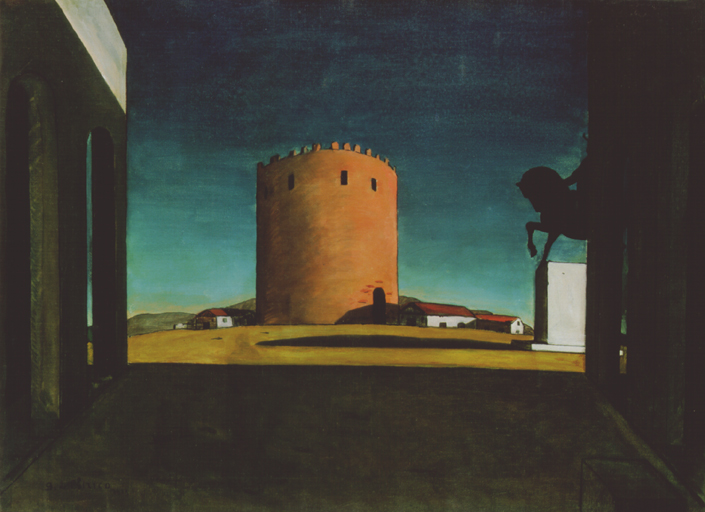 The Red Tower - 1913, Giorgio de Chirico
Giorgio de Chirico was born to Italian parents in Vólos, Greece, on July 10, 1888. In 1900 he began studies at the Athens Polytechnic Institute and attended evening classes in drawing from the nude. About 1906 he moved to Munich, where he attended the Akademie der Bildenden Künste. At this time he became interested in the art of Arnold Böcklin and Max Klinger and the writings of Friedrich Nietzsche and Arthur Schopenhauer. De Chirico moved to Milan in 1909, to Florence in 1910, and to Paris in 1911. In Paris he was included in the Salon d’Automne in 1912 and 1913 and in the Salon des Indépendants in 1913 and 1914. As a frequent visitor to Guillaume Apollinaire’s weekly gatherings, he met Constantin Brancusi, André Derain, Max Jacob, and others. Because of the war, in 1915 de Chirico returned to Italy, where he met Filippo de Pisis in 1916 and Carlo Carrà in 1917; they formed the group that was later called the Scuola Metafisica.
The Red Tower - 1913, Giorgio de Chirico
Giorgio de Chirico was born to Italian parents in Vólos, Greece, on July 10, 1888. In 1900 he began studies at the Athens Polytechnic Institute and attended evening classes in drawing from the nude. About 1906 he moved to Munich, where he attended the Akademie der Bildenden Künste. At this time he became interested in the art of Arnold Böcklin and Max Klinger and the writings of Friedrich Nietzsche and Arthur Schopenhauer. De Chirico moved to Milan in 1909, to Florence in 1910, and to Paris in 1911. In Paris he was included in the Salon d’Automne in 1912 and 1913 and in the Salon des Indépendants in 1913 and 1914. As a frequent visitor to Guillaume Apollinaire’s weekly gatherings, he met Constantin Brancusi, André Derain, Max Jacob, and others. Because of the war, in 1915 de Chirico returned to Italy, where he met Filippo de Pisis in 1916 and Carlo Carrà in 1917; they formed the group that was later called the Scuola Metafisica.
The artist moved to Rome in 1918, and was given his first solo exhibition at the Casa d’Arte Bragaglia in that city in the winter of 1918–19. In this period he was one of the leaders of the Gruppo Valori Plastici, with whom he showed at the Nationalgalerie in Berlin. From 1920 to 1924 he divided his time between Rome and Florence. A solo exhibition of de Chirico’s work was held at the Galleria Arte in Milan in 1921, and he participated in the Venice Biennale for the first time in 1924. In 1925 the artist returned to Paris, where he exhibited that year at Léonce Rosenberg’s Galerie l’Effort Moderne. In Paris his work was shown at the Galerie Paul Guillaume in 1926 and 1927 and at the Galerie Jeanne Bucher in 1927. In 1928 he was given solo shows at the Arthur Tooth Gallery in London and the Valentine Gallery in New York. In 1929 de Chirico designed scenery and costumes for Sergei Diaghilev’s production of the ballet Le Bal, and his book Hebdomeros was published. The artist designed for the ballet and opera in subsequent years, and continued to exhibit in Europe, the United States, Canada, and Japan. In 1945 the first part of his book Memorie della mia vita appeared. De Chirico died on November 20, 1978, in Rome, his residence for over thirty years.
|
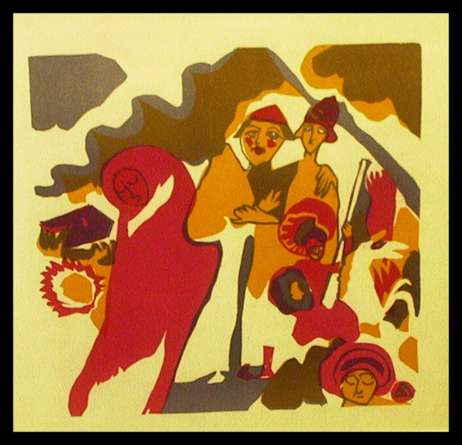 Red Tan, Vasily Kandinsky
Vasily Kandinsky was born December 4, 1866, in Moscow. From 1886–92, he studied law and economics at the University of Moscow, where he lectured after graduation. In 1896, he declined a teaching position in order to study art in Munich with Anton Azbe from 1897 to 1899 and at the Kunstakademie with Franz von Stuck in 1900. Kandinsky taught in 1901–03 at the art school of the Phalanx, a group he had cofounded in Munich. One of his students, Gabriele Münter, would be his companion until 1914. In 1902, Kandinsky exhibited for the first time with the Berlin Secession and produced his first woodcuts. In 1903 and 1904, he began his travels in Italy, the Netherlands, and North Africa and his visits to Russia. He showed at the Salon d’Automne in Paris from 1904.
Red Tan, Vasily Kandinsky
Vasily Kandinsky was born December 4, 1866, in Moscow. From 1886–92, he studied law and economics at the University of Moscow, where he lectured after graduation. In 1896, he declined a teaching position in order to study art in Munich with Anton Azbe from 1897 to 1899 and at the Kunstakademie with Franz von Stuck in 1900. Kandinsky taught in 1901–03 at the art school of the Phalanx, a group he had cofounded in Munich. One of his students, Gabriele Münter, would be his companion until 1914. In 1902, Kandinsky exhibited for the first time with the Berlin Secession and produced his first woodcuts. In 1903 and 1904, he began his travels in Italy, the Netherlands, and North Africa and his visits to Russia. He showed at the Salon d’Automne in Paris from 1904.
In 1909, Kandinsky was elected president of the newly founded Neue Künstlervereinigung München (NKVM). The group’s first show took place at Heinrich Thannhauser’s Moderne Galerie in Munich in 1909. In 1911, Kandinsky and Franz Marc began to make plans for Der Blaue Reiter Almanac, although the publication would not appear until the following year. Kandinsky’s On the Spiritual in Art was published in December 1911. He and Marc withdrew from the NKVM in that month, and shortly thereafter the Blaue Reiter group’s first exhibition was held at the Moderne Galerie. In 1912, the second Blaue Reiter show was held at the Galerie Hans Goltz, Munich. Kandinsky’s first solo show was held at Der Sturm gallery in Berlin in 1912. In 1913, one of his works was included in the Armory Show in New York and the Erste deutsche Herbstsalon at the Der Sturm gallery in Berlin. Kandinsky lived in Russia from 1914 to 1921, principally in Moscow, where he held a position at the People’s Commissariat of Education.
Kandinsky began teaching at the Bauhaus in Weimar in 1922. In 1923, he was given his first solo show in New York by the Société Anonyme, of which he became vice-president. Lyonel Feininger, Alexej Jawlensky, Kandinsky, and Paul Klee made up the Blaue Vier group, formed in 1924. He moved with the Bauhaus to Dessau in 1925 and became a German citizen in 1928. The Nazi government closed the Bauhaus in 1933 and later that year Kandinsky settled in Neuilly-sur-Seine, near Paris; he acquired French citizenship in 1939. Fifty-seven of his works were confiscated by the Nazis in the 1937 purge of “degenerate art.” Kandinsky died December 13, 1944, in Neuilly.
|
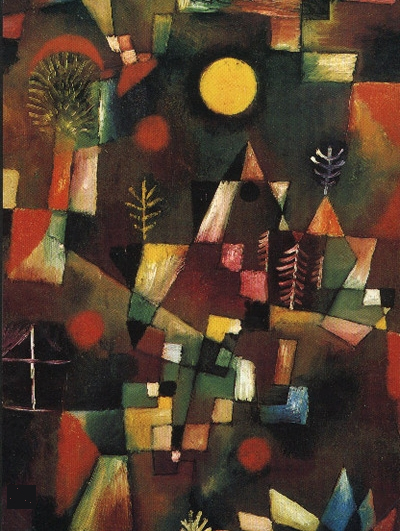 The Moon, Paul Klee
Paul Klee was born on December 18, 1879, in Münchenbuchsee, Switzerland, into a family of musicians. His childhood love of music was always to remain profoundly important in his life and work. From 1898 to 1901, Klee studied in Munich, first with Heinrich Knirr, then at the Kunstakademie under Franz von Stuck. Upon completing his schooling, he traveled to Italy in the first in a series of trips abroad that nourished his visual sensibilities. He settled in Bern in 1902. A series of his satirical etchings was exhibited at the Munich Secession in 1906. That same year, Klee married Lily Stumpf, a pianist, and moved to Munich. Here he gained exposure to Modern art. Klee’s work was shown at the Kunstmuseum Bern in 1910 and at Moderne Galerie, Munich, in 1911.
The Moon, Paul Klee
Paul Klee was born on December 18, 1879, in Münchenbuchsee, Switzerland, into a family of musicians. His childhood love of music was always to remain profoundly important in his life and work. From 1898 to 1901, Klee studied in Munich, first with Heinrich Knirr, then at the Kunstakademie under Franz von Stuck. Upon completing his schooling, he traveled to Italy in the first in a series of trips abroad that nourished his visual sensibilities. He settled in Bern in 1902. A series of his satirical etchings was exhibited at the Munich Secession in 1906. That same year, Klee married Lily Stumpf, a pianist, and moved to Munich. Here he gained exposure to Modern art. Klee’s work was shown at the Kunstmuseum Bern in 1910 and at Moderne Galerie, Munich, in 1911.
Klee met Alexej Jawlensky, Vasily Kandinsky, August Macke, Franz Marc, and other avant-garde figures in 1911; he participated in important shows of advanced art, including the second Blaue Reiter exhibition at Galerie Hans Goltz, Munich, in 1912, and the Erste deutsche Herbstsalon at the Der Sturm Gallery, Berlin, in 1913. In 1912, he visited Paris for the second time, where he saw the work of Georges Braque and Pablo Picasso and met Robert Delaunay. Klee helped found the Neue Münchner Secession in 1914. Color became central to his art only after a revelatory trip to Tunisia in 1914.
In 1920, a major Klee retrospective was held at the Galerie Hans Goltz, Munich; his Schöpferische Konfession was published; he was also appointed to the faculty of the Bauhaus. Klee taught at the Bauhaus in Weimar from 1921 to 1926 and in Dessau from 1926 to 1931. During his tenure, he was in close contact with other Bauhaus masters, such as Kandinsky and Lyonel Feininger. In 1924, the Blaue Vier, consisting of Lyonel Feininger, Jawlensky, Kandinsky, and Klee, was founded. Among his notable exhibitions of this period were his first in the United States at the Société Anonyme, New York, in 1924; his first major show in Paris the following year at the Galerie Vavin-Raspail; and an exhibition at the Museum of Modern Art, New York, in 1930. Klee went to Düsseldorf to teach at the Akademie in 1931, shortly before the Nazis closed the Bauhaus. Forced by the Nazis to leave his position in Düsseldorf in 1933, Klee settled in Bern the following year. Seventeen of his works were included in the Nazi exhibition of “degenerate art,” Entartete Kunst, in 1937. Major Klee exhibitions took place in Bern and Basel in 1935 and in Zurich in 1940. Klee died on June 29, 1940, in Muralto-Locarno, Switzerland.
|
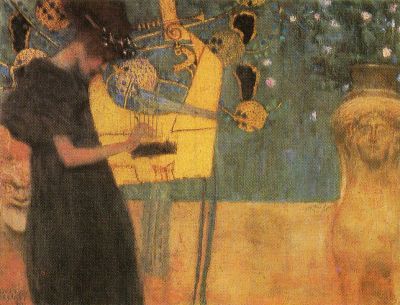 The Music, Gustav Klimt
Gustav Klimt (1862-1918) was one of the most innovative and controversial artists of the early twentieth century. The son of an engraver, he studied at the State School of Applied Arts in Vienna. In the 1880s and 1890s he produced murals for public buildings -- including Vienna's Burgtheater and new Kunsthistorisches Museum (Art History Museum) -- in the prevailing classical-realist style. Klimt's style grew increasingly experimental, however, and his murals for Vienna University, commissioned by the State in 1894, were roundly attacked by critics for their fantastical imagery and their bold, decorative style. Partly in response to this reaction, in 1897 Klimt helped form the Secession, a group of artists dedicated to challenging the conservative Academy of Fine Arts. Influenced by European avant-garde movements represented in the annual Secession exhibitions, Klimt's mature style combined richly decorative surface patterning with complex symbolism and allegory, often with overtly erotic content.
The Music, Gustav Klimt
Gustav Klimt (1862-1918) was one of the most innovative and controversial artists of the early twentieth century. The son of an engraver, he studied at the State School of Applied Arts in Vienna. In the 1880s and 1890s he produced murals for public buildings -- including Vienna's Burgtheater and new Kunsthistorisches Museum (Art History Museum) -- in the prevailing classical-realist style. Klimt's style grew increasingly experimental, however, and his murals for Vienna University, commissioned by the State in 1894, were roundly attacked by critics for their fantastical imagery and their bold, decorative style. Partly in response to this reaction, in 1897 Klimt helped form the Secession, a group of artists dedicated to challenging the conservative Academy of Fine Arts. Influenced by European avant-garde movements represented in the annual Secession exhibitions, Klimt's mature style combined richly decorative surface patterning with complex symbolism and allegory, often with overtly erotic content.
After 1900 he concentrated on portraits and landscapes, although he also produced two of his greatest murals during this period -- The Beethoven Frieze, exhibited at the Secession in 1902, and decorations for the Palais Stoclet in Brussels (1904-1911). Klimt spent most of his summers on the Attersee, near Salzburg, where he drew inspiration for many of his landscapes, and where he painted some of his best-known works, including The Kiss of 1907-8.
|
 Jain Temples, Frank Taylor
Jain Temples, Frank Taylor
|
 Radiant Light, Wolf Kahn
Working within a predominantly abstractionist context, a group of younger artists forged a mode of representational art in the 1950s and 1960s that made use of Abstract Expressionist painterly freedom and spontaneity in order to document the life around them. However, subject matter, including human figures, was recognizable, which was much against the grain of most of their peers.
Radiant Light, Wolf Kahn
Working within a predominantly abstractionist context, a group of younger artists forged a mode of representational art in the 1950s and 1960s that made use of Abstract Expressionist painterly freedom and spontaneity in order to document the life around them. However, subject matter, including human figures, was recognizable, which was much against the grain of most of their peers.
Wolf Kahn, one of the leaders of this group and a native of Stuttgart, Germany, directed this approach toward the painting of the landscape, which he has steadfastly developed over a period of forty years. With studios in New York and Vermont, he has been a colorist who uses simplified geometric designs and contrasting, carefully balanced colors. He has a fascination with barns that date to 1966 when he did a work titled "First Barn Painting." He returned to this subject throughout the 70s and 80s. In 1999, a major exhibition of his work was held at the Morris Museum of Art in Augusta Georgia.
Today Kahn's use of color has placed him at the forefront of American representational Art, and has made him one of the most highly regarded colorists working in America today. He has received Fulbright and Guggenheim Fellowships, and an Award in Art from the American Academy and Institute for Arts and Letters.
Credit: Web site of Virginia Lynch Gallery. Tiverton Rhode Island
|
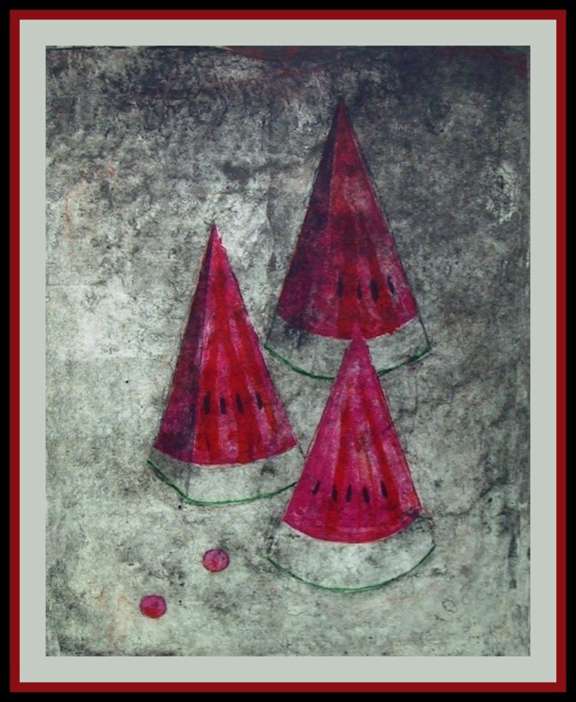 Sangrias, Ruffino Tamayo
Rufino Tamayo was born on August 26, 1899, in Oaxaca, Mexico. Orphaned by 1911, he moved to Mexico City to live with an aunt who sent him to commercial school. Tamayo began taking drawing lessons in 1915 and by 1917 had left school to devote himself entirely to the study of art. In 1921 he was appointed head of the Department of Ethnographic Drawing at the Museo Nacional de Arqueología, Mexico City, where his duties included drawing pre-Columbian objects in the museum’s collection. Tamayo integrated the forms and slate tones of pre-Columbian ceramics into his early still lifes and portraits of Mexican men and women.
Sangrias, Ruffino Tamayo
Rufino Tamayo was born on August 26, 1899, in Oaxaca, Mexico. Orphaned by 1911, he moved to Mexico City to live with an aunt who sent him to commercial school. Tamayo began taking drawing lessons in 1915 and by 1917 had left school to devote himself entirely to the study of art. In 1921 he was appointed head of the Department of Ethnographic Drawing at the Museo Nacional de Arqueología, Mexico City, where his duties included drawing pre-Columbian objects in the museum’s collection. Tamayo integrated the forms and slate tones of pre-Columbian ceramics into his early still lifes and portraits of Mexican men and women.
The first exhibition of Tamayo’s work in the United States was held at the Weyhe Gallery, New York, in 1926. The first of his many mural commissions was given to him by the Escuela Nacional de Música in Mexico City in 1932. In 1936 the artist moved to New York, and throughout the late thirties and early forties the Valentine Gallery, New York, gave him shows. He taught for nine years, beginning in 1938, at the Dalton School in New York. In 1948 Tamayo’s first retrospective took place at the Instituto de Bellas Artes, Mexico City. Tamayo was influenced by European Modernism during his stay in New York and when he traveled in Europe in 1957. In that year he settled in Paris, where he executed a mural for the UNESCO Building in 1958. Tamayo returned to Mexico City in 1964, making it his permanent home. The French government named him Chevalier and Officier de la Légion d’Honneur in 1956 and 1969, respectively, and he was the recipient of numerous other honors and awards. His work was exhibited internationally in group and solo shows. Important Tamayo retrospectives took place at the São Paulo Bienal in 1977 and the Solomon R. Guggenheim Museum, New York, in 1979. He died in Mexico City on June 24, 1991.
|
|
|
